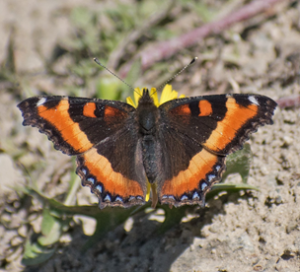Join the Second Vermont Butterfly Atlas

Vermonters now have another excuse to get outside on sunny days: to join a statewide survey of the most angelic insects—butterflies. The Vermont Center for Ecostudies (VCE) is recruiting volunteers to help search fields and fens, mountains and meadows, and even their own backyards to help document the status of Vermont’s butterflies.
Butterflies were largely a mystery in Vermont before hundreds of volunteer community scientists helped complete the first Vermont Butterfly Atlas (2002-2007), heralding a new era for their conservation. Twenty years later, the second atlas is poised to detect changes in butterfly populations and provide essential information for environmental management and policy.
“The 2nd Vermont Butterfly Atlas is a rare opportunity for us to understand long-term trends in butterfly populations and prescribe conservation actions to both keep common species common and reverse the trends for those in trouble,” said Kent McFarland, VCE biologist and director of the atlas.
The Vermont Butterfly Atlas is a five-year survey completed every 20 years to document the abundance, distribution, and conservation status of butterflies across Vermont with the help of volunteer community scientists. It is part of a network of atlases across the Northeast, spanning from Connecticut through the Canadian Maritimes, and gives a landscape view of the butterfly fauna invaluable for conservation and a priceless snapshot for future comparisons. Vermont is poised to be the first state or province in the region to repeat a butterfly atlas 20 years later.
Most anyone with a sharp eye can contribute. Everyone knows what a butterfly looks like, and many carry a digital camera at all times—their smartphones. With a bit of training, it’s easy to watch butterflies and report results to the Vermont Butterfly Atlas at e-Butterfly.org, a worldwide butterfly reporting system built by VCE, the Montreal Space for Life, and other partners. There is even a built-in computer vision system to help users identify the butterflies in their images.
“We’re excited to offer training sessions for new participants at butterfly hotspots across the state as well as online workshops on butterfly atlasing,” said Nathaniel Sharp, VCE biologist and atlas coordinator. “While there are tons of great field guides and online resources listed on our website, getting outside searching for butterflies is the best way to meet other butterfly lovers, learn how to identify our local species, and get motivated to document the butterflies in your neighborhood and beyond.”
Vermont is home to over 100 butterfly species, with several new species discovered by butterfly watchers since the last butterfly atlas, including North America’s largest butterfly, the Eastern Giant Swallowtail.
“Name a color, and you’ll find it on a butterfly’s wing,” McFarland said. “Yet butterflies can also tell us a lot about the state of Vermont’s environment under the forces of changing land use practices, climate change, and other human-induced pressures.”
Financial support for the atlas is provided by the Vermont Department of Fish & Wildlife – State Wildlife Grant, Charles E. & Edna T. Brundage Foundation, Davis Conservation Foundation, the Park Foundation, and individual supporters and donors of the Vermont Center for Ecostudies.
To learn more and join the survey, visit the Vermont Butterfly Atlas